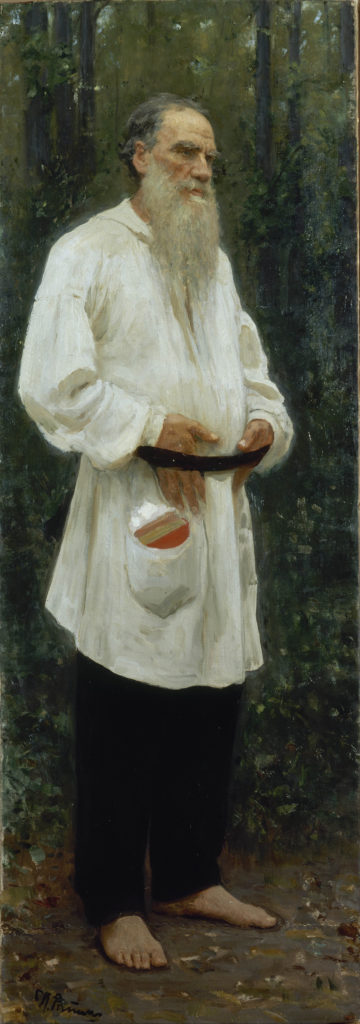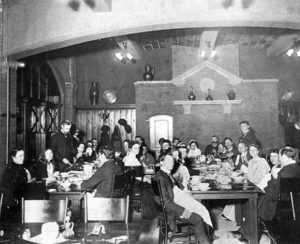Addams’ affection and admiration for Tolstoy is evident in both her correspondences and her published works. In her 1910 book Twenty Years at Hull-House, Addams recollected her visit to the Count’s residence in Russia. She embarked in search of the answer to a question: “I was most eager to know whether Tolstoy’s undertaking to do his daily share of the physical labor of the world, that labor which is ‘so disproportionate to the unnourished strength’ of those by whom it is ordinarily performed, had brought him peace?”

Addams gave a lecture in 1902 in which she explained the four types of labor Tolstoy believed every person should partake in. She noted that “he would, of course, always excuse the ill, the aged, and little children” but believed that the bulk of people should perform manual and skilled labor as well as engage in literary work and social effort. According to Tolstoy, by reducing the amount of “brutal and dehumanizing” labor that one performs it gives those unaccustomed to performing that type of labor a perspective that will change the way they view their own lives and commodities. Addams spoke of skilled labor: “If we had some of this experience we would try to simplify our lives, because we would then realize, as we do not now, some of the work on which it is founded. Many people would then stop wearing many things, and having many things in their houses which are not needed.”
Many people fear meeting their favorite celebrity since it is possible it will result in embarrassment or the shattering of a previously held illusion. Addams likely experienced both upon meeting the revered author. She recounted the “distrustful” manner with which Tolstoy regarded the sleeves of her dress during their first meeting. Tolstoy, who was clad in peasant’s clothes, commented on the excessive amount of fabric on Addams’ dress and remarked that “there was enough stuff on one arm to make a frock for a little girl.”
Despite originally feeling disconcerted, Tolstoy’s comments did not dissuade Addams from searching for the answer to her question. Addams recalled a particular instance in which she attended dinner with Tolstoy, his family, and his traveling guests in Twenty Years. She wrote:
The countess presided over the usual European dinner served by men, but the count and the daughter, who had worked all day in the fields, ate only porridge and black bread and drank only kvas, the fare of the hay-making peasants. Of course we are all accustomed to the fact that those who perform the heaviest labor eat the coarsest and simplest fare at the end of the day, but it is not often that we sit at the same table with them while we ourselves eat the more elaborate food prepared by someone else’s labor. Tolstoy ate his simple supper without remark or comment upon the food his family and guests preferred to eat, assuming that they, as well as he, had settled the matter with their own consciences.

Addams’ time among Tolstoy, his family, and the peasants elicited such strong feelings in her that she made a mental vow to spend two hours each morning in the bakery which had recently been added to the coffee house at Hull-House. Upon her return she realized her vision was not possible due to her overwhelming responsibilities. In Twenty Years she wrote: “The half dozen people invariably waiting to see me after breakfast, the piles of letters to be opened and answered, the demand of actual and pressing wants—were these all to be pushed aside and asked to wait while I saved my soul by two hours’ work at baking bread?”
Earlier she pointed out Tolstoy’s difficult stance:
Doubtless all of the visitors sitting in the Tolstoy garden that evening had excused themselves from laboring with their hands upon the theory that they were doing something more valuable for society in other ways. No one among our contemporaries has dissented from this point of view so violently as Tolstoy himself, and yet no man might so easily have excused himself from hard and rough work on the basis of his genius and of his intellectual contributions to the world.
While Addams admired Tolstoy, his way of life was incompatible with the life she had already established in Chicago. She wished to emulate him in some capacity, but her duties to Hull-House subsumed a great deal of her time. While writing books, giving lectures, traveling, and worrying about her own health and the health of her friends and family, Addams was always finding new ways to improve Hull-House. It is no surprise, then, that she was incapable of designating even two hours each morning to bake bread. The question remains: how might one find a compromise between Addams’ way of life and Tolstoy’s?
Hull-House later received five hundred dollars which were left over from Tolstoy’s profit from publishing his novel Resurrection. The bulk of the profit was given to the Dukhobors, a Russian religious group who had recently settled in Canada with the help of their government. When faced with the choice of what to spend the money on, Addams felt that it was only natural to use it “for the relief of the most primitive wants of food and shelter on the part of the most needy families.”
Ultimately, Addams assisted the Nineteenth Ward without spending two hours per day in the Coffee Shop baking bread. Instead, she used her talent as social reformer to improve the lives of those living in poverty around her. Although she saw the value in performing manual labor, Addams realized there was greater value, in her situation, in devoting her working hours to her role as the head figure of Hull-House.
Julianne De Lisi is an Editorial Assistant with the Jane Addams Papers Project. She is currently a junior Literature Major at Ramapo intending on pursuing her MLIS (with a concentration in either archives or public libraries) after graduating. In addition to her major she has an interest in women’s studies and has volunteered at the historic landmark and museum The Hermitage in Ho-Ho-Kus, New Jersey.

